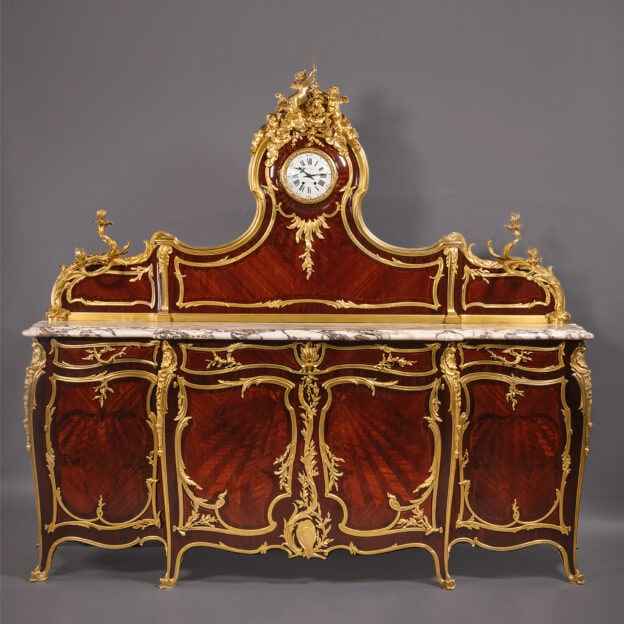Guillaume et Jean-Michel Grohé
Grande et exceptionnelle pendule de cheminée de style Louis XVI en bronze doré et marbre blanc.
£15,500
A Large and Exceptional Louis XVI Style Gilt-Bronze and White Marble Figural Mantel Clock, By Grohé Frères, Paris. The dial signed ‘Grohé, A Paris'....
Dimensions
Height: 45 cm (18 in)Width: 48 cm (19 in)
Depth: 42 cm (17 in)
Description
A Large and Exceptional Louis XVI Style Gilt-Bronze and White Marble Figural Mantel Clock, By Grohé Frères, Paris.
The dial signed ‘Grohé, A Paris’. The movement stamped with ‘Japy Frères’ roundel to the backplate.
Eight-day twin-train movement with outside countwheel striking on a bell.
Of impressive size this fine gilt-bronze and marble clock has a circular white enamel dial with Roman numerals and inscribed ‘Grohé, A Paris’ to the centre behind a hinged glazed bezel. The case is finely cast with a charming figure of Cupid seated with a dove and scribbling onto a scroll which rests over the dial of the clock. The case is raised on a white marble oval base mounted with a laurel cast band.
Guillaume & Jean-Michel Grohé went into partnership in 1829 and formed the atelier “Grohé Frères” in 1847. They went on to supply the highest quality furniture, furnishings, clocks, and bronzes to European royalty including Prince Albert at the Paris Exhibition of 1855.
Français, Circa 1870.
Japy Frères
Frédéric Japy (1749-1812) a fait son apprentissage à Montbéliard auprès de son oncle horloger, puis il est retourné dans sa ville natale de Beaucort, où il s'est installé comme horloger et a organisé les horlogers locaux en une société - la société s'est développée et a été médaillée à de nombreuses expositions internationales tout au long du 19e siècle sous l'égide de ses fils, avant de fermer après la Première Guerre mondiale.
Date
Circa 1870
Origine
France
Moyen
Doré-bronze
Signature
The dial signed ‘Grohé, A Paris'. The movement stamped with ‘Japy Frères’ roundel to the backplate.
Guillaume and Jean-Michel Grohé, worked together from 1829 until Jean-Michel retired in 1861, the younger brother Guillaume continuing until 1884. They exhibited at the French Industrial Exhibition in 1834, and in 1847 became known as Grohé Frères with Guillaume the principal partner.
Guillaume supplied many royal houses, including Queen Victoria, from 1862 onwards. He was also said to have made a great impression on, and supplied furniture to King Louis Philippe, Emperor Napoléon III and Empress Eugénie. Guillaume favoured the Louis XVI style but made pieces in differing styles, exhibiting almost continually from 1834 to 1878. Guillaume was awarded the Légion d‚’Honneur in 1849.
The work of Grohé was praised in the 1867 Paris Exposition Universelle as ‚‘supérieurs √† ceux de Riesener et Gouthière‚’ (‚‘superior to those of Riesener and Gouthière‚’).
Bibliography:
Meyer, Jonathan. Great Exhibitions – London, New York, Paris, Philadelphia, 1851-1900, Antique Collectors’ Club, (Woodbridge, UK), 2006; pps. 97, 98, 100, 230.
Ledoux – Lebard, Denise. Les Ébénistes du XIXe siècle, Les Editions de L’Amateur, (Paris), 1984; pp. 237-244.
Mestdagh, Camille & Lécoules, Pierre. L’Ameublement d’Art Français, 1850-1900, Les Editions de L’Amateur, (Paris), 2010.
VOUS POUVEZ ÉGALEMENT AIMER
-
£5,000 Ajouter au panier

Vincenti et Cie.
Pendule de cheminée en émail de style Louis XVI
-
£9,000 Ajouter au panier

Sèvres (Style)
Pendule de cheminée en porcelaine de Sèvres en bronze doré et fond bleu céleste, fine et élaborée.
-
£85,000 Ajouter au panier

Denière
Une rare Garniture Monumentale d'Horloge Cercles Tournants















 Imprimer
Imprimer